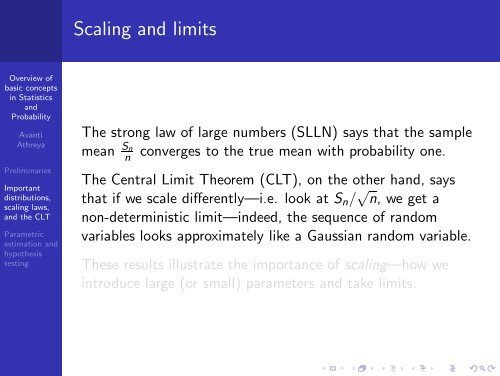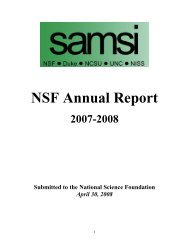Overview of basic concepts in Statistics and Probability - SAMSI
Overview of basic concepts in Statistics and Probability - SAMSI
Overview of basic concepts in Statistics and Probability - SAMSI
You also want an ePaper? Increase the reach of your titles
YUMPU automatically turns print PDFs into web optimized ePapers that Google loves.
Scal<strong>in</strong>g <strong>and</strong> limits<br />
<strong>Overview</strong> <strong>of</strong><br />
<strong>basic</strong> <strong>concepts</strong><br />
<strong>in</strong> <strong>Statistics</strong><br />
<strong>and</strong><br />
<strong>Probability</strong><br />
Avanti<br />
Athreya<br />
Prelim<strong>in</strong>aries<br />
Important<br />
distributions,<br />
scal<strong>in</strong>g laws,<br />
<strong>and</strong> the CLT<br />
Parametric<br />
estimation <strong>and</strong><br />
hypothesis<br />
test<strong>in</strong>g<br />
The strong law <strong>of</strong> large numbers (SLLN) says that the sample<br />
mean Sn<br />
n<br />
converges to the true mean with probability one.<br />
The Central Limit Theorem (CLT), on the other h<strong>and</strong>, says<br />
that if we scale differently—i.e. look at S n / √ n, we get a<br />
non-determ<strong>in</strong>istic limit—<strong>in</strong>deed, the sequence <strong>of</strong> r<strong>and</strong>om<br />
variables looks approximately like a Gaussian r<strong>and</strong>om variable.<br />
These results illustrate the importance <strong>of</strong> scal<strong>in</strong>g—how we<br />
<strong>in</strong>troduce large (or small) parameters <strong>and</strong> take limits.
















